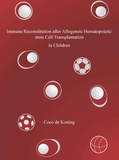Immune Reconstitution after Allogeneic Hematopoietic stem Cell Transplantation in Children
Summary
An allogeneic hematopoietic stem cell transplantation is the only curative treatment option for children suffering from chemo-refractory leukemia or inborn errors such as metabolic diseases. During this therapy, the diseased bone marrow cells of the patient are replaced by stem cells from a healthy donor. After infusion of the donor stem cells, these cells find their way into the bone marrow of the patient, where they engraft and start differentiating into new immune cells. This essential process is called immune reconstitution. Since the first successful transplantation in 1968, the treatment of patients with this therapy has drastically improved over the last years. Despite of this, complications in this risky procedure are still common, causing 30-50% of patients to die after transplantation. This is why it is important to better understand what causes these complications, and how to better predict them. During my research, I found that children with a delayed immune reconstitution after their transplantation had much more complications and lower chance of survival. In particular a fast and adequate reconstitution of T-cells, the so-called soldiers of the immune system, is essential for lowering complications such as virus infections, graft-versus-host disease, and leukemia relapse. My research also describes different factors that affect the speed of T-cell reconstitution. These novel findings enable improvement of the treatment of patients who undergo a stem cell transplantation, which are expected to drastically enhance the survival chances of future transplantation recipients.
